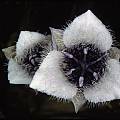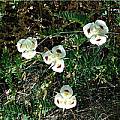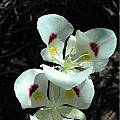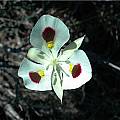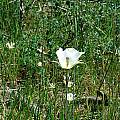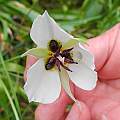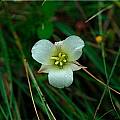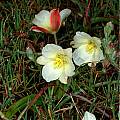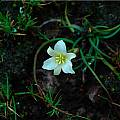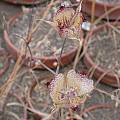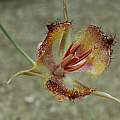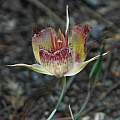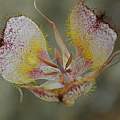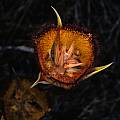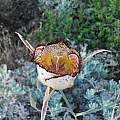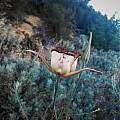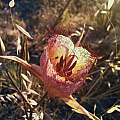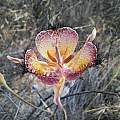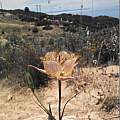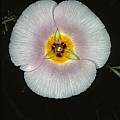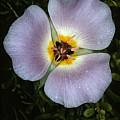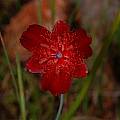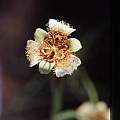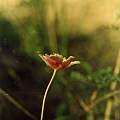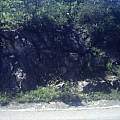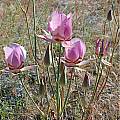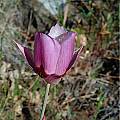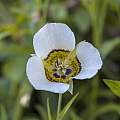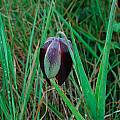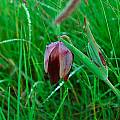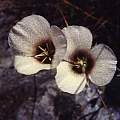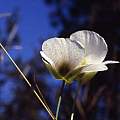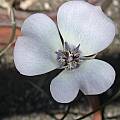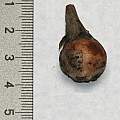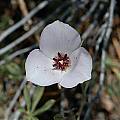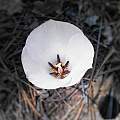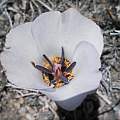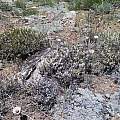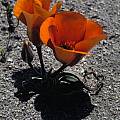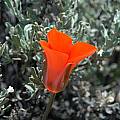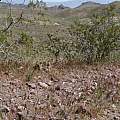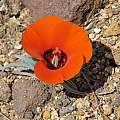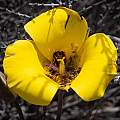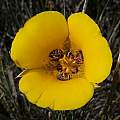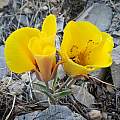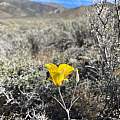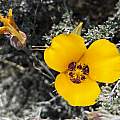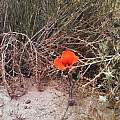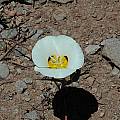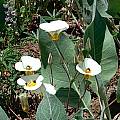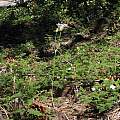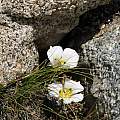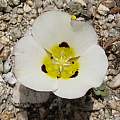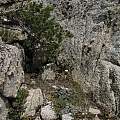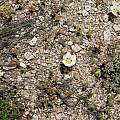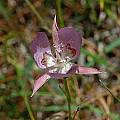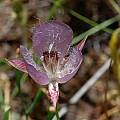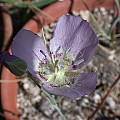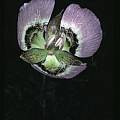Calochortus is a genus in the Liliaceae family with species distributed in western North America, Mexico, and south to Guatemala. The greatest concentration of species is found in California. Three good sources of information are Frank Callahan, The Genus Calochortus, in McGary, 2001 found listed in References, Calochortus, Gerritsen and Parsons, 2007 found listed in References, and Mariposa, the newsletter of the Calochortus Society, a quarterly issued between 1989 and 2005. Calochortus species starting with e and ending with lo are found on this page.
Calochortus species a-b - Calochortus species c-d - Calochortus species lu-n - Calochortus species o-r - Calochortus species s - Calochortus species t-u - Calochortus species v-z - Calochortus hybrids - Calochortus index
Calochortus elegans Pursh is classified in Section Calochortus, Subsection Eleganti (Cat's ears or Pussy ears). This is the type species of the genus, discovered (1806) by Meriwether Lewis on the famous Lewis and Clark expedition near what is today Kamiah, Idaho. This is a widespread species with several recognized varieties (also Calochortus elegans var. nanus Alph.Wood, Calochortus elegans var. selwayensis (H.St.John) Ownbey). It can be up to 15-20 cm tall, but rarely. Usually the stems are under 8 cm, and bear one to seven upright, bowl shaped flowers. The species is found from western parts of Montana and Idaho into southeast Washington, northeast Oregon, southwest Oregon and northern California. The plants are usually found on the margins of coniferous forests or on grassy slopes in open woods. This species was featured in Mariposa,Volume 1,#3. The photo below is Calochortus elegans var. elegans and is from a population found in Emigrant Springs State Park, Union County, Oregon. Photo by Ron Parsons.
Calochortus eurycarpus Watson, also known as Wide-Fruit Mariposa Lily and Star Tulip , is in Section Calochortus, Subsection Nitidus. This is a very attractive species, with 10-55 cm stems that are rarely branched bearing one to five, open bowl shaped flowers. It is quite a widespread species found in parts of Washington, Idaho, Montana, Wyoming, and western Utah. It also occurs in a variety of habitats, from grasslands, sage brush slopes and even in open coniferous (and deciduous) forests, at elevations of 1100-2700 m. This species was featured in Mariposa,Volume 2,#1.
Comments from Hugh McDonald of the Calochortus Society: Grows in high mountain meadows (4800 feet / 1500 m) in Oregon, in part shade or near low shrubs, among low grasses that help shade the base. Precipitation varies from 10 inches to 30 inches per year, much of it in the form of snow. Snowmelt probably triggers germination in the spring. The species gets some summer rain. Hardy to -30 °F (-35 °C). Blooms in late spring to early summer; it has a short growing season. Prefers cold winters and mild summers. In a cold climate, you could put seeds outdoors in a large pot with snow on top of it. In warmer climates, you'll need to stratify the seeds for 6-10 weeks.
The photos below were taken at various localities in Idaho, north of Ketchum. July 2007. Photos by Mary Gerritsen.
Calochortus excavatus Greene is a rare eastern Californian endemic from Mono and Inyo counties. It occurs in snow melt fed, alkaline, moist meadows at elevations of 980-1500 m. It has one to eight upright white to lavender blushed flowers with a yellow, purplish brown to black base with a circular to transversely oval deeply depressed gland densely covered in blackish hairs. The reddish brown to dark purple anthers are obtuse at the apex and equal to the filaments in length. This species is reported to be difficult to cultivate, needing a prolonged cold, dry period in winter and a drained gravelly soil mix. This species was featured in Mariposa,Volume 10,#3. Height range: 10-30 cm. Photo was taken by Mary Sue Ittner in Jane McGary's bulb house.
Calochortus exilis Painter is the smallest species of section Cyclobothra, with erect to somewhat lax stems, up to 10 cm high, with two to four upright, shallow, bowl-shaped flowers. This species is limited to the state of Hidalgo, Mexico, where it occurs at quite high elevations (2500-3000 m). The photos shown below were taken in a recreation area of the Nacional Parque El Chico, above Pachuca, Hildago State, Mexico in September, 2007. Elevation was about 2600 m. Photos by Mary Gerritsen.
Calochortus fimbriatus H.P.McDonald was until recently classified as a variety of Calochortus weedii var. vestus Purdy but has been given a distinct taxon in 2000. This species is in subsection Weediani. A very distinct feature of this species is the double row of fringed hairs on the petals. It occurs more northerly of Calochortus weedii, endemic to Monterey, San Luis Obispo and Santa Barbara counties where it is found in the South Coast ranges. It also is found further inland in Ventura county. The plants grow in dry coast scrub, open woodlands and chaparral, at elevations up to 900 m. This is one of the latest blooming Calochortus species, often in flower from late July to mid-August. This species was featured (as Calochortus weedii var. vestus) in Mariposa,Volume 12,#2. Height range: 2-3 ft.
The first photo from Jane McGary is of plants grown from bulbs purchased from Telos Rare Bulbs as Calochortus weedii var. vestus. Plunged in an unheated bulb frame in northwestern Oregon, they flower in late July. The next three pictures from Mary Sue Ittner show the first blooming of plants labeled the same grown from Northwest Native seeds. Photos were taken on different days to show the progression. The last photo was taken in Monterey County, California by Ron Parsons.
Excerpts and photos from Kipp McMichael's "Calochortus pursuits":
"Our final destination was the ridge line behind Santa Barbara and Monetcito, CA. On the undulating ridge spine composed of alternating sandstone and granite outcrops grows my personal pick for prettiest Calochortus of them all: Calochortus fimbriatus. These large plants grow 2-3 feet tall with several blooms per stem, each overflowing with brightly colored hairs and mottled with beautiful pinks, reds, and purples. We caught the bloom very early so the true variety of colors and patterns went largely unsampled. Even from such a "sneak peak" however, we found many truly beautiful blossoms."
Calochortus flexuosus S.Watson, commonly known as the Winding or Twining Mariposa Lily, is a desert species found in southeast California, southern Nevada, southwest Utah, central Arizona, and southwest Colorado. It is also found in Baja California and Sonora Mexico. It gets its name from its vine-like habit of twining up through nearby shrubs and cacti. Height range: 15-30 cm. Photos taken by Ron Parsons are of wild populations in Nevada, early May, 1993.
Calochortus fuscus Schult.f., also known as Hinton's cyclobothra, has also been described as Calochortus hintonii but the later was reduced to synonmy with Calochortus fuscus in 1963. It is one of the Mexican Calochortus, section Cyclobothra, subsection Ghiesbreghtiani. This small flowered species has erect flexuous glaucous branching stems 30-60 cm in height, with two to four 2-2.5 cm shallow bowl shaped to nearly flat flowers. It is known from the Mexican states of Chihuahua, Jalisco, Mexico, Michoacan and Oaxaca, where it occurs at 900-2300 m in oak and pine forest. The photo below was taken in the state of Jalisco, September 2006. Photo by Mary Gerritsen
Calochortus ghiesbreghtii S.Watson is found in three Mexican states, Queretaro, Hidalgo, and Chiapas, and southward to Guatemala and is the southernmost known species in the entire genus where it grows in limestone soils at elevations from 1200 to 2600 m. It is a summer rainfall species that flowers August to September. It has bowl shaped to flat white to yellowish hairy flowers. Many flowers have a reddish area near the base and on the back. This species was featured in Mariposa,Volume 7,#3. Height: to about 25 cm. Photos from Hugh McDonald.
Calochortus greenei, also known as Greene's Mariposa, is a localized species that occurs in Siskiyou County, California, and in Jackson and Klamath Counties, Oregon. It is usually found on grassy slopes at elevations of 700-1100 m. This species was featured in Mariposa,Volume 13,#1. Height range: 10-40 cm. Photos were taken in June, 2007 by Mary Gerritsen.
Calochortus gunnisonii S. Watson is a wide ranging species, with a principally Rocky Mountain distribution, from central Montana, south through Wyoming, Colorado, eastern Utah and some disjunct populations in New Mexico, southwest South Dakota and eastern Arizona. It is found in a variety of habitats, including grasslands, open pine forests, edges of aspen groves, mountain meadows, high elevation sagebrush and limestone slopes. It is generally found at fairly high elevations (1000-3300 m). This species was featured in Mariposa,Volume 7,#1. Height range: 20-50 cm. Photo 1 by Ron Parsons, taken in the Grand Mesa National Forest, Delta County, Colorado. Photo 2 by Christopher Poplawski was taken in habitat at Bierstadt Lake Trail, Rocky Mountain National Park, Estes Park, Colorado on August 8th, 2011.
Calochortus hartwegii Benth. is one of Mexican species of Calochortus, Section Cyclobothra, subsection Purpurei. This robust species has erect, sometimes branched, bulbiferous, glaucous stems that are 30-75 cm tall, with two to three large (4.5-7 cm) flowers borne on stout peduncles. The stature of this plant and large flower are quite distinctive. This species ranges from Zacatecas to Aguascalientes, Nayarit and Jalisco states. The photos below are from a hilly area outside of the city of Guadalajara, and were taken in September, 2006. Photos by Mary Gerritsen
Calochortus howellii S.Watson is a species with a limited distribution in southwest Oregon. It grows in hot, dry scrub and open woodlands at elevations of 400 to 1350 m in soils derived from serpentine. It has white bowl-shaped flowers with smoky-brown hairs above a dark, hairy gland above a yellow-green petal claw. It flowers late June to July. This species was featured in Mariposa,Volume 9,#1. Height range: 20-40 cm. Photos from Hugh McDonald.
Calochortus invenustus Greene has a disjunct range in coastal southern California, the southern Sierra Nevada, and the Bodie Hills of Nevada, growing in scrub and open pine woodland at higher elevations. It has an unusually blue color for the genus and is reputed to be difficult to grow. Height range: 30-50 cm. Photo 1 from Jane McGary pictures plants grown from Ron Ratko's seed collection that were grown in a bulb frame in northern Oregon, kept dry in summer. Photo 2 from Nhu Nguyen shows the bulb. Photos 3-4 were taken at Mt. Pinos, Kern County, in July of 2006 by Mary Gerritsen. She writes: "This species, also known as the "Plain Mariposa Lily" is far from that. It has a delicate beauty of its own, but at least in one locality, it grows not far from the very showy, highly colorful, Calochortus venustus."
Excerpts and photos from Kipp McMichael's "Calochortus pursuits":
"We returned as well to the summit of Mt. Pinos to see the flowers of C. invenustus whose leaves we had observed in relative profusion on our earlier visit. It was a good year for C. invenustus and the alpine meadows were liberally sprinkled with its nearly stemless, lightly purple-tinged blooms."
Calochortus kennedyi Porter, also known as the "Desert Mariposa Lily" is stunning when you see it in the wild. It is a wildflower favorite, with erect to somewhat lax, glaucous stems, 10-60 cm tall. The height depends somewhat on the openness of the habitat. In the open it tends to be short and stout, whereas when growing up through shrubs it tends to be tall and thin. An individual plant may have up to eight cup shaped flowers, 3-5 cm, usually with a rounded to slightly pointed margin. The petals can be scarlet, vermilion, orange, yellow orange or even brilliant yellow. This species has a quite broad distribution, occurring in southern and eastern California, southern Nevada, the Big Bend area of west Texas, and in addition, the states of Sonora, Chihuahua and Coahuila in Mexico. It is found on heavy or rocky soil in creosote-bush scrub, pinyon/juniper woodland at 600-2200 m. and flowers April to June. This species was featured in Mariposa,Volume 3,#1. The nominate form has orange to red petals. Calochortus kennedyi var. munzii Jeps. has yellow petals with dark purple-brown anthers.
The Calochortus Society labeled this bulb difficult but not impossible to grow. The challenge is to avoid giving it too much water. It is a desert species, and receives less than 15 inches of rain a year throughout most of its range. The Society recommended mimicking the plant's native rainfall patterns, in which infrequent storms drop torrents of water but are separated by long dry spells. So the recommendation was to thoroughly drench the pot, and then wait two weeks before watering again. Or, they said, the species can do well in California if given no supplemental water, just allowing it to live on rain water that falls on the pot. Temperature can also be an issue -- the bulbs grow at a time of year when temperatures are cold to moderate in the desert. The pots should not be allowed to overheat while the bulb is in growth. C. kennedyi can dive deep, so pot depths of 18 inches were recommended. Seeds from high-altitude selections of C. kennedyi may need cold stratification.
Photos below are of the typical orange form, Calochortus kennedyi var. kennedyi. The first was taken by Ron Parsons in Inyo county, California, and the second by Mary Gerritsen, a flower in profile, in the vicinity of Mt. Pinos (lower elevation) Kern County, CA. The last three pictures were taken by Carolyn Saarni in the Mojave Desert, Inyo County, California at 3500 ft (325 meters) April 2009.
The first three photos from Calflora of Calochortus kennedyi var. munzii were taken by John L. Thompson May 2019 in San Bernardino county, California, and shared under a CC BY-NC license. The last two photos from Calflora were taken by Dee Shea Himes May 2022 in Inyo County, California and shared under a CC BY-NC license.
Excerpts and photos from Kipp McMichael's "Calochortus pursuits":
"We finished at Casper's around 6 PM and resolved to shoot for a room for the night near Lebec, CA. We left the Motel 6 early the next morning and headed for Mt. Pinos. This area boasts brilliant red Calochortus venustus as well as the alpine-loving Calochortus invenustus near the summit of the mountain. Alas, we were far too early for either Calochortus - but the plants growing in the alpine meadow of the summit were nonetheless a treat to observe. The grasslike leaves of Calochortus invenustus were common in the alpine meadows and we resolved to return again later in the season to catch them in bloom. As we drove away from Mt. Pinos on Lockwood Valley Road, the brilliant vermillion of Calochortus kennedyi leapt out at me from the roadside. We stopped the car and explored the sage brush hillside to find a handful of plants - many of which had flowers opening at ground level on stems 1/2" tall.
Calochortus leichtlinii Hook.f. is a species often found at quite high elevations in three western states: Oregon, California and Nevada. The plants are generally found in open exposed situations in alpine and montane coniferous forests, at elevations ranging from 750-4000 m. This species was featured in Mariposa,Volume 14,#2. Height range: 30-60 cm. Photos 1-2 by Mary Gerritsen are from a population at the top of a ridge above Donner Pass, California (July 2006). Photo 3 was taken by Nhu Nguyen of a plant growing in more shaded conditions in Yosemite National Park, CA.
The photos below were taken by Nhu Nguyen of plants on Sonora Pass, CA. They were growing in decayed granite soil with very little organic matter. The plants are usually found tucked in small shrubs or by some rocks.
Calochortus longebarbatus S.Watson is a plant of subalpine to alpine meadows with an extensive disjunct range from central Washington state to Shasta County, California. This species was featured in Mariposa,Volume 5,#3. Height range: 10-30 cm. There are two recognized varieties of Calochortus longebarbatus. The nominate variety is Calochortus longebarbatus var. longebarbatus, and it is the most widespread and commonly seen form, depicted below from a population in Modoc county, California, mid-July, 2006. The first two photos from Mary Gerritsen. The third photo from Jane McGary of plants grown from seed collected by the Leach Botanical Garden, Portland, Oregon shows the long, ragged petal hairs that give it its name. Callahan suggests some moisture throughout the year, although the plants are fairly dry in summer (though plunged in a bulb frame, where the soil stays faintly moist).
The other form, Calochortus longebarbatus var. peckii Ownbey, is found in Central Oregon in the Ochocho mountains. This variety is actually triploid, and Ownbey estimated that it had reproduced vegetatively for over 500,000 years. It is distinguished from the nominate variety by its shorter stature, broader and shorter petals, and the transverse petal band is usually darker. Photo by Ron Parsons.
Calochortus species a-b - Calochortus species c-d - Calochortus species lu-n - Calochortus species o-r - Calochortus species s - Calochortus species t-u - Calochortus species v-z - Calochortus hybrids - Calochortus index
